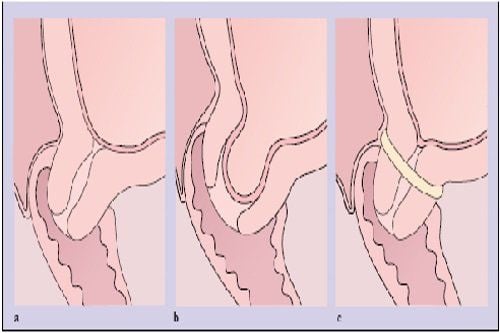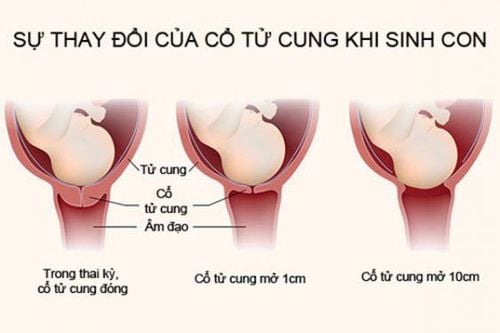This is an automatically translated article.
Preterm labor is when a woman has signs of early labor before 37 weeks of pregnancy. For babies born early (premature birth) there is a high risk of health problems at birth, as well as during life. Premature babies need to stay in the hospital longer than full-term babies.1. What are the symptoms of preterm labor?
Signs of preterm labor include:
Lower abdominal pain as if it's coming month Abdominal contractions every 10 minutes or so Nausea, vomiting or diarrhea Dull back pain Heavy, tight feeling Pelvic or lower abdomen Abdominal cramps Abnormal vaginal discharge such as wetness with mucus or some blood Prematurity rupture of membranes, water flowing continuously from the vagina after the membrane surrounding the baby has ruptured. When to see a doctor:
If you experience the above signs or symptoms, go to the hospital immediately for timely examination and treatment. Pregnant women should not be subjective or confused because some may be common symptoms during pregnancy, not premature birth. But to be sure, women should see a doctor to rule out preterm labor.
Trắc nghiệm: Dấu hiệu cảnh báo chuyển dạ thực sự
Chuyển dạ là quá trình thai phụ bước vào giai đoạn “đẻ đau” để kết thúc thời gian “mang nặng”. Thời gian và dấu hiệu chuyển dạ sẽ khác nhau tùy vào vào từng người và nhiều yếu tố. Theo dõi bài trắc nghiệm dưới đây sẽ giúp bạn hiểu rõ hơn các dấu hiệu chuyển dạ một cách chính xác và an toàn.2. Which women are more likely to give birth prematurely?
Many different factors can increase the risk of premature labor, including:
Smoking Having a history of premature birth Problems with the uterus, cervix or placenta Being overweight, overweight or underweight before pregnancy Not getting good care during pregnancy Drinking alcohol or using drugs during pregnancy Having medical conditions such as high blood pressure, pre-eclampsia, diabetes, blood clotting disorders, or genital infections Stress straight or life events such as death of a loved one Polyhydramnios Fetus with birth defects In vitro fertilization Multiple pregnancy Family history of preterm labor Getting pregnant too soon after giving birth.

Sản phụ có huyết áp cao, tiền sản giật,... dễ bị sinh non
3. Complications of Premature Birth
The earlier a baby is born, the more likely they are to have problems after birth such as low birth weight, difficulty breathing, underdeveloped organs and vision problems. Most premature babies with good care will develop fully and catch up with full-term babies. However, these children are at high risk of some health problems later in life such as autism, intellectual disability, cerebral palsy, lung problems, vision and hearing loss.
4. Treatment of preterm labor
Medicines
During labor, there are no drugs or surgical procedures to stop labor. However, the doctor may use the following drugs:
Corticosteroids: If you are between 24 and 34 weeks pregnant, your doctor may prescribe strong steroid injections to speed up fetal lung maturation. Corticosteroids may also be recommended starting at 23 weeks of pregnancy if you are at risk of giving birth within the next seven days. Alternatively, corticosteroids may be used between 34 and 36 weeks, if the woman is at risk of delivery within the next seven days and has not previously received corticosteroids. Magnesium sulfate is used when the woman is at risk of childbirth. high between weeks 24 and 32 of pregnancy. Some studies have shown that magnesium sulfate can reduce the risk of a type of brain damage (cerebral palsy) in babies born before 32 weeks of Tocolytics to temporarily stop a mother's contractions. . However, these drugs cannot stop preterm labor for longer than two days because they do not address the underlying cause of preterm birth. However, Tocolytics can delay preterm labor long enough to maximize the benefits of corticosteroids or, if necessary, refer the woman to a specialist facility for intensive care for both mother and baby. Tocolytics are not used in certain situations, such as gestational hypertension. Surgery
For some women, the cervix will need to be sutured because of the short cervix to keep the amniotic fluid and the fetus developing normally in the womb. In this technique, the cervix is closed with sutures. Usually, sutures are removed after 36 weeks, however, if necessary, sutures can be removed earlier.
Cervical suture is recommended if you are less than 24 weeks pregnant, have a history of preterm birth, and ultrasound shows an open cervix or if your cervix is less than 25 mm long.

Hình ảnh khâu eo cổ tử cung
5. Prevention of preterm labor
While preterm labor cannot be prevented, there are things you can do to increase your chances of having a healthy, full-term pregnancy. For example:
Regular prenatal check-ups for doctors to monitor the health of mother and baby. If you have a history of preterm labor or develop signs or symptoms of preterm labor, you may need to see your doctor more often during your pregnancy. Several recent studies have shown that a diet high in polyunsaturated fats (PUFAs) reduces the risk of preterm birth, so it is recommended that pregnant women eat foods rich in PUFAs found in nuts. , nuts, fish and nut oils Quit smoking and stay away from secondhand smoke Consider spacing pregnancy. Some studies show that continuing a pregnancy less than six months old increases the risk of preterm birth. If you're planning to use assisted reproduction to get pregnant, consider how many embryos will be implantation in the mother's uterus due to multiple pregnancies has a higher risk of preterm birth compared with singleton pregnancies. If your doctor determines that you are at risk for preterm labor, he or she may recommend that you take additional steps to reduce your risk, such as:
Take preventive medicine. If you have a history of preterm birth, your doctor will prescribe weekly injections of a form of the hormone progesterone called hydroxyprogesterone caproate starting in the second trimester and continuing until week 37. Alternatively, progesterone may be given. vaginally to prevent premature birth. If you are diagnosed with a short cervix before week 24 of your pregnancy, your doctor may also recommend that you take progesterone until week 37 Managing chronic conditions like diabetes and high blood pressure, which are all disease increases the risk of preterm birth.

Đăng kí thai sản trọn gói tại Bệnh viện Đa khoa Quốc tế Vinmec - an tâm làm mẹ, trọn vẹn niềm vui
The Maternity Package at Vinmec International General Hospital helps customers complete antenatal check-ups and necessary tests during pregnancy, in order to minimize the risk of preterm birth. Customers registered for Maternity Package are fully cared for and checked for health of mother and baby before birth - during childbirth and after birth, fully and conscientiously.
Currently Vinmec has maternity packages including:
Maternity care program 2019 – Labor Maternity care program 2019 – 36 weeks Maternity care program 2019 – 27 weeks Pregnancy care program Production 2019 – 12 weeks
Please dial HOTLINE for more information or register for an appointment HERE. Download MyVinmec app to make appointments faster and to manage your bookings easily.
References: Webmd.com, Mayoclinic.org, Acog.org












